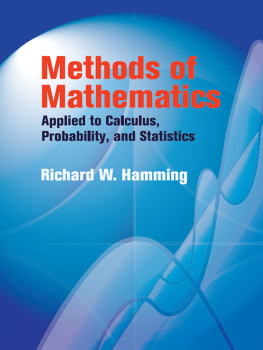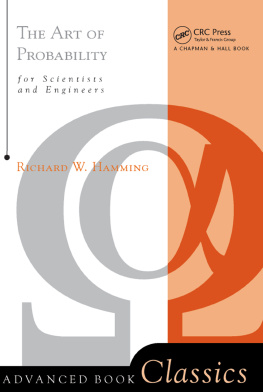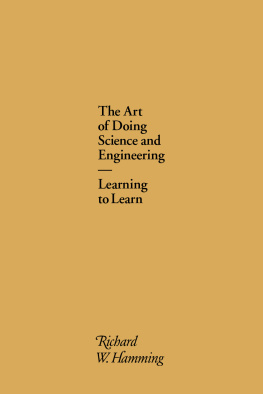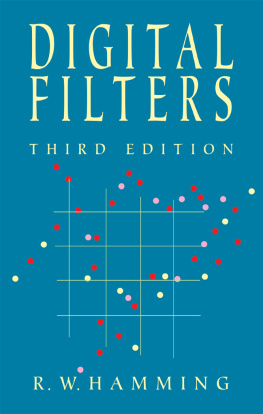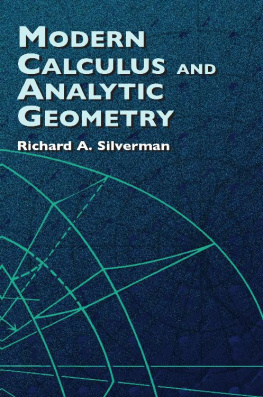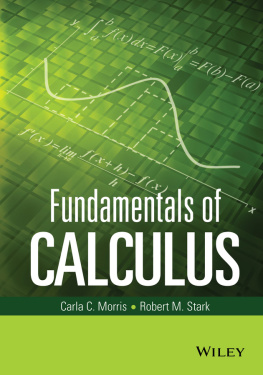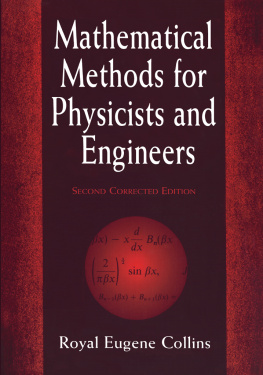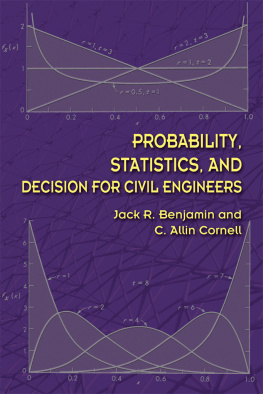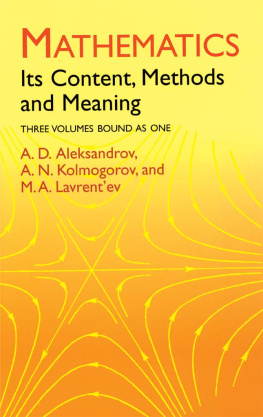Methods of Mathematics
Applied to Calculus,
Probability, and Statistics
Methods of Mathematics
Applied to Calculus,
Probability, and Statistics
RICHARD W. HAMMING
Naval Postgraduate School
Monterey, California
Dover Publications, Inc.
Mineola, New York
Copyright
Copyright 1985 Richard W. Hamming
All rights reserved.
Bibliographical Note
This Dover edition, first published in 2004, is an unabridged republication of the edition published by Prentice-Hall, Inc., Englewood Cliffs, New Jersey, 1985.
Library of Congress Cataloging-in-Publication Data
Hamming, R. W. (Richard Wesley), 1915
Methods of mathematics applied to calculus, probability, and statistics / Richard W. Hamming.
p. cm.
Originally published: Englewood Cliffs, N.J. : Prentice-Hall, c1985.
Includes index.
ISBN 0-486-43945-3 (pbk.)
1. Mathematics I. Title.
QA37.3H35 2004
510dc22
2004053443
Manufactured in the United States of America
Dover Publications, Inc., 31 East 2nd Street, Mineola, N.Y. 11501
Preface
Why another calculus book? One reason is that this is not the conventional calculus book. I agree with de Finetti (1906), who says in his Theory of Probability:
To add one more [book] would certainly be a presumptuous undertaking if I thought in terms of doing something better, and a useless undertaking if I were to content myself with producing something similar to the standard type.
My second reason comes from a remark L. E. Dickson (18741954) once made in class with respect to his History of the Theory of Numbers:
Every scientist owes a labor of love to his field.
This book is my labor of love.
The title, when the individual words are examined, explains the differences between this book and the current standard calculus texts.
1. Methods
By methods I mean those methods that are widely used in mathematics, science, and the applications of mathematics. Methods are important. It is by applying the methods that we obtain the results of mathematics. We are rapidly approaching an infinite amount of knowledge in the form of results, both in what is known and in what is useful in the applications of mathematics to other fields. Thus it is increasingly futile to teach mathematics by trying to cover the needed material; instead we must teach the methods and how to re-create the material as it is needed. We must abandon the methods of retrieval for those of regeneration. This may be an unscholarly attitude, but there seems little hope for the future if we persist in going down the path of the retrieval of knowledge.
2. of Mathematics
This means that the emphasis is on those methods that are peculiar to mathematics, that is, its abstractions and its methods of reasoning. In my opinion these should no longer be neglected. Some of the methods used in science generally are also specifically mentioned. Finally, many of the philosophical questions that naturally occur to the student while learning mathematics will be examined rather than cleverly evaded or simply glossed over.
3. Applied to
The book shows how the methods of doing mathematics are applied to both mathematics itself and to various uses of mathematics in other fields. Mathematicians tend to view mathematics as an art done for arts sake, but it is well known that the majority of the students in the typical calculus class expect to use mathematics rather than merely admire it. The neglect of either aspect, the innate beauty or the richness of applications, is foolish.
4. Calculus
The calculus is probably the most useful single branch of mathematics. During the many years of using mathematics daily in industry I found that the ability to do simple calculus, easily and reliably, was the most valuable part of all the mathematics I ever learned (of course, I also used more advanced mathematics whenever it was appropriate). My views, therefore, were shaped by the almost daily use of the calculus rather than by occasionally teaching the conventional courses. As a result this book is different from the standard, thick, exhausting text that is crammed with specific results and is short on the understanding of mathematics. The current form of calculus texts has apparently been popular since at least the first appearance of Granvilles Calculus in 1904.
Understanding the methods of the calculus is vital to the creative use of mathematics in many areas even today. Without this mastery the average scientist or engineer, or any other user of mathematics, will be perpetually stunted in development, and will at best be able to follow only what the textbooks say; with mastery, new things can be done, even in old, well-established fields. Progress involves, among other things, the constant revision of the elements of a field, as well as the creation of significant new results.
5. Probability
The calculus arose from problems in mechanics, and for all of the nineteenth century and more, mechanical and electrical applications have dominated its use. These problems involve almost no probability. At present, probability plays a central role in many fields, from quantum mechanics to information theory, and even older fields use probability now that the presence of noise is officially admitted. The newer aspects of many fields start with the admission of uncertainty.
Although many great mathematicians contributed to the early development of probability theory, it was not generally considered an integral part of mathematics until the publication of Fellers (19061970) book (1950) [F] (references are found at the end of ). Since then probability has played an increasing role in mathematics.
6. and Statistics
Statistics has had an even slower acceptance in mathematics than probability. Yet statistics is central to much of our lives. We are deluged by statistics from surveys, polls, advertisements, government publications, and even data from laboratory experiments where we have gone beyond the deterministic world view to the acceptance of randomness as being fundamental.
Furthermore, it is probable that a large fraction of the students enrolled in the calculus course are there because the course is needed for statistics. Statistics without the calculus can only be of the cookbook variety. If the student is ever to master and use the simple concept of the distribution of a statistic (the values of a statistic that can be expected from repeated trials of the same experiment), then it is vital that the calculus be mastered. Continuous distributions are basic to the theory of probability and statistics, and the calculus is necessary to handle them with any ease.
It is understandable that many mathematicians do not like statistics, but it should be taught early so that the concepts are absorbed by the students flexible, adaptable mind before it is too late. I believe that the students needs require that some parts of mathematical statistics be included in the mathematics curriculum.
This book is not a course in probability or statistics; only the more mathematical parts are discussed at all. The much more difficult part of statistics, often called data analysis, is left entirely to the professional statisticians to teach. But using some of the functions and ideas that arise in statistics to illustrate various principles of the calculus and mathematics generally seems a sensible thing to do, rather than using arbitrarily made up functions and artificial problems.
This book emphasizes discrete mathematics (mathematics associated mainly with the integers) much more than does the usual calculus text. Increasingly these days the application of mathematics to the real world involves discrete mathematics. As most mathematicians who have examined the question at all closely know, discrete mathematics often involves the use of continuous mathematicsthe nature of the discrete is often most clearly revealed through the continuous models of both calculus and probability. Without continuous mathematics, the study of discrete mathematics soon becomes trivial and very limited. Hence such topics as difference equations, generating functions, and numerical methods are scattered throughout the book as well as in special sections and chapters. In particular, the idea is rejected that for computer scientists a course in discrete mathematics without the calculus is adequate. The two topics, discrete and continuous mathematics, are both ill served by being rigidly separated.
Next page
